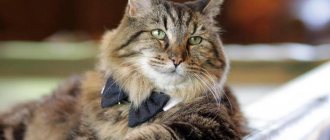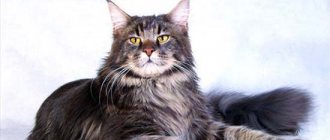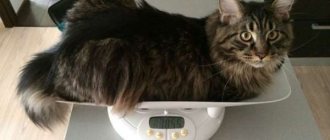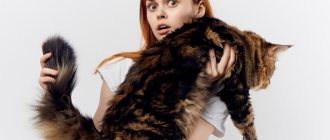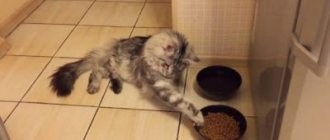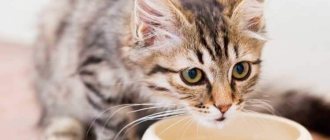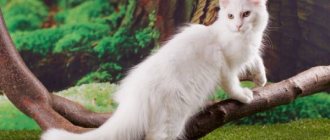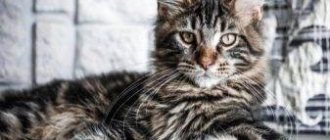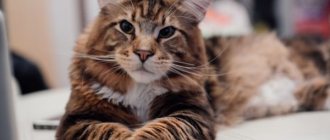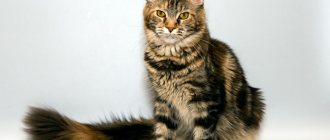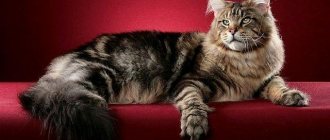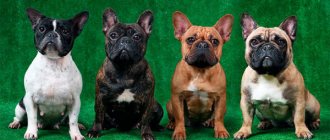Maine Coon cats have a beautiful coat color, a stern and intelligent look and impressive dimensions. Their absolutely unique set of characteristics and habits deserves special attention. These cats combine calmness, balance, curiosity, friendliness and independence. At the same time, they are very active and energetic.
Differences between cats and cats
The first noticeable difference, other than gender characteristics, between cats and Maine Coon cats is that males are larger and heavier. As cats grow older, they become more stubborn, independent and willful, fully demonstrating their innate tendency to dominate and confidence in their own superiority. It is especially important from childhood to accustom them not only to hygiene procedures, but also to obedience, otherwise it will be difficult to cope with an adult pet.
Cats are less affectionate and you should not expect bright manifestations of love and affection from them.
At the same time, like faithful dogs, they relentlessly follow on the heels of their owner.
It seems that at any moment they are ready to carry out any assignment.
During the period of sexual heat, cats can behave aggressively, try to run outside, and scratch doors. They jealously guard their space and mark their territory. At the same time, like wild predators, the urine of Maine Coon males has a sharper and heavier odor than that of females, and even castration does not help solve this problem.
Cats are more affectionate and friendly, they tend to express their love for their owner and make every effort to win his favor. In addition, their character is much more flexible, they make concessions, and it is easier to find a compromise with a cat than with a stubborn cat. Females have better developed hunting instincts, and they are more aggressive towards rodents and birds. At the same time, it is believed that they understand the difference between street prey and pets, but testing this in practice is still risky.
Cats are cleaner and are ready to spend hours brushing their fur, getting real pleasure from it. With the onset of puberty, females may change their character and behave strangely during estrus.
Severe forest dweller: appearance of Maine Coons
There are strong differences in the appearance of males and females. Kitties are more graceful, weighing only 4-8 kg, and the weight of adult cats can reach 10-12 kg. The gigantism of Maine Coons is greatly exaggerated; the average weight of a cat is 7-9 kg. Even though some manufacturers reach a weight of 14 kg, this does not mean that the pet will weigh the same.
Maine Coons are one of the largest domestic cats!
The long muscular body looks harmonious, the coons are proportionally built. They have powerful paws, and a lot of fur between their toes: their paws resemble snowshoes.
In addition to their size, Maine Coons are distinguished by their luxurious coat. An incredibly long and fluffy tail that a cat can wrap itself in while sleeping. The length of the tail is equal to the length of the body.
The coat consists of a light curly undercoat and dense, smooth guard hairs, which reach 10-15 cm in some areas. Coons have long fur on their bellies, fluffy fur panties, and a collar (mane) around their necks.
Relative to the body, the head looks small. The large ears are decorated with long tassels, making the cat resemble a lynx. There are tufts of hair in the ears. Maine Coons have a longer muzzle than most domestic cats. A wide nose and a massive chin, like a tiger or a lion - the whole appearance indicates that this is a predator, a hunter.
Wide nose and massive chin. Maine Coon cannot be confused with anyone else.
Nowadays Maine Coons come in all colors except Siamese (color point). The traditional wild color is agouti (spotted-striped), but in Russia you can find pure white or pure black Maine Coons. Eye color can be any.
Black Maine Coon kitten
White coons have an unusual phenomenon - heterochromia, when the cat has eyes of different colors. You can read more about this and see photos of odd-eyed cats HERE (the link will open in a new tab).
White Maine Coon kitten
Like large dogs, large cats mature slowly. The Maine Coon is considered mature and formed only at 3 years old.
Maine Coon weighing 12 kg
Activity
Despite the fact that Maine Coons prefer open space, they easily get used to life in city apartments.
But at the same time, it would be a mistake to expect that these cats will spend all their time in peace and sleep; they are not phlegmatic at all.
By nature, Maine Coons are rather sanguine.
They need constant movement, active games, and communication. To satisfy the desire of representatives of this breed to constantly do something, you should purchase special toys, scratching posts, and complexes. In this case, this is not a whim or pampering, but a necessity - without them, hyperactive pets will find an outlet for their energy through damage to property, albeit unintentionally.
You cannot limit the activity of a Maine Coon - this will negatively affect the development of its skeleton and muscles.
These cats love to walk outside and feel quite comfortable in a harness, but before such walks they need to undergo a full course of vaccination and flea and tick treatment.
Care and maintenance
Maine Coons can be brushed at home as needed; this should not be a problem. Particular attention should be paid to the areas on the back and sides - the fur is thicker there and tangles can form. You should also arrange bathing procedures once every three to four weeks. Maine Coons are not afraid of water, so there should not be any problems. Make sure to choose the right shampoo so that it does not harm the animal.
The inside of the cats ears should be pinkish. Pet stores sell special wipes for ear and eye hygiene. But you can clean them using a soft cloth or napkin.
To protect yourself from damaged wallpaper and scratches, and also to help your cat with claw points, you need to give your pet a manicure and pedicure once a week.
For Maine Coons, you should purchase a tray that has a larger area than standard ones. It is also recommended to buy closed trays, as some representatives of this breed like to scatter the filler, burying “their business.”
The general rules for caring for and maintaining a Maine Coon are no different from the rules for caring for any long-haired cat. Trimming the claws, cleaning the ears, eyes, teeth and regular brushing is all that is needed for a giant cat.
Intelligence
Another distinctive feature of Maine Coons is their high level of intelligence. They are observant, thoughtful and smart. Cats of this breed have excellent memory. Thanks to this, they are easy to train. They master many commands without problems, and easily find a common language with family members, remembering their intonations, gestures, and capturing their emotions.
Often the actions of Maine Coons are conscious. So, they can learn to open doors by pressing the handle, and even easily become accustomed to the toilet. These cats have a lively, tenacious mind, they are interested in everything that surrounds them - they love to look out the window, at the computer or TV monitor. The subject of their attention and interest are all moving objects and images that make sounds.
Physiological characteristics of Maine coon cats
These are the largest domestic cats. For an adult male, a weight of more than 8 kg can be considered normal, but in some cases an adult cat weighs 14 kg or more. The weight of a female rarely exceeds 6 kg, although there are exceptions.
A special feature of this breed is its long growth period - the animal will need from 3 to 5 years to reach its final size. The average height of Maine Coons is 30–40 cm, body length is up to 1.2 m, of which almost 40 cm is the tail.
Average statistical data on the weight of animals, depending on age:
| Kitten age | Cat weight | Cat weight |
| Newborn kitten | 100–140 g. | 120–160 g. |
| 1 Week | 160–230 g. | 190–250 g. |
| 2 weeks | 160–230 g. | 190–250 g. |
| 3 weeks | 420–550 g. | 440–600 g. |
| 1 month/4 weeks | 560–680 | 630–750 g. |
| 2 months/8 weeks | 1.1–1.4 kg. | 1.2–1.5 kg. |
| 3 months/12 weeks | 1.7–2.4 kg. | 2.8–3.6 kg. |
| 4 months/16 weeks | 2.7–3.6 kg. | 3–3.8 kg. |
| 5 months/20 weeks | 2.8–3.9 kg. | 3.2–4.2 kg. |
| 6 months/24 weeks | 3.2–4 kg. | 3.8–4.5 kg. |
| 7 months | 3.6–4.7 kg. | 4.2–5.6 kg. |
| 8 months | 3.8–4.9 kg. | 4.5–6.1 kg. |
| 9 months | 4.1–5.8 kg. | 4.6–6.8 kg. |
| 10 months | 4.3–6.5 kg. | 4.8–7.2 kg. |
| 11 months | 4.3–7 kg. | 5–7.5 kg. |
| 1 year/12 months | 4.5–8.3 kg. | 5.4–8.8 kg. |
| 5 years | 5–8.5 kg. | 5.8–12 kg. |
Maine Coon kitten, male, 3 months
Main phenotypes of Maine Coons (photo gallery)
Silver or smoky - the lower half of the hairs are not colored
Solid or solid - uniform, monochromatic color, regardless of gender
Tabby - with a variety of chaotic patterns on the body
With white - the presence of white spots up to albinism, regardless of gender
Tortoiseshells - the color combines red and black, only females
These phenotypes may vary in the following qualities:
- by the color of the main tone (black, blue, red, cream, black and blue-cream tortoiseshell, silver or smoke, white);
- according to the type of white spotting (van, harlequin, two-color, with white);
- by type of tabby pattern (marbled or classic tabby, tiger tabby or mackerel, spotted, agouti factor, shaded, chinchilla).
Variations of Maine Coon phenotypes (photo gallery)
Adult Maine Coon, male, white solid with heterochromia
Adult Maine Coon, male, red tabby
Adult Maine Coon, male, silver classic tabby
Adult female Maine Coon, black tabby
Maine Coon kitten, 3–4 months, black tortoiseshell and white
Habits and characteristics
| Habits, features | Description |
| Love for water | Unlike most cats, representatives of this breed enjoy all bath procedures. They are interested in water, they like to bathe in baths or open bodies of water, and sometimes rinse pieces of food in a bowl of water before eating it. It is also interesting how they drink - first they dip their paw in the water, lick it and only after that they start drinking. According to felinologists, this attitude towards water is associated with the natural habitat of these cats and the need of their ancestors to clean the water in streams from leaves and debris with their paws. |
| Voice | Maine Coons almost never meow or hiss. They purr and the sounds they make are unique and reminiscent of birds chirping. |
| Parental instinct | There is no need to separate male and female cats after the kittens are born. Male Maine Coons do not show aggression towards their offspring. Moreover, they strive to take care of the kids, participate in their upbringing, pass on their knowledge and skills and teach basic cat habits. |
| Using paws while eating | The likelihood that representatives of this breed will eat with their nose in a bowl is almost zero. As a rule, they eat with their paws, picking up pieces of food from the bowl with their claws. |
| Lack of tendency to steal | The problem of cats stealing and eating food from the owner’s table is not uncommon. But with Maine Coons you don’t have to worry about this - if they climb onto the table, it’s only to make it more convenient to look out the window. |
Breeding
Diseases and pathologies associated with the cardiovascular system and musculoskeletal system are hereditary for coons.
The breed should be bred by professionals in specialized nurseries.
Pedigree animals require careful selection of a pair, veterinary care, felinological education, communication with breeders and enormous material resources.
It is much easier to become the owner of a breeding cat as part of a cattery. The nursery will help you gain access to good quality animals for breeding and will assist in the sale of kittens.
Mating and partner selection
It is much easier to become the owner of a breeding cat as part of a cattery.
The search for a partner and mating of a breeding animal is carried out through specialized clubs. For regular mating, you can look for a partner at an exhibition or through an advertisement.
Animals younger than one year old should not be allowed to breed; it is optimal to postpone this until the third year of life.
Basic rules of mating:
- Mating takes place on the cat's territory, which gives him more confidence.
- It is advisable to trim the animal's claws.
- The cat should not be washed before mating.
- Both animals must have all necessary vaccinations.
Pregnancy and childbirth
Pregnancy in large cats is longer than in other breeds, lasting 9-10 weeks. Its duration depends on the number of kittens in the litter: the fewer kittens, the longer the cat bears them.
Coons usually give birth to offspring once a year, with babies in a litter ranging from 1 to 6.
If the owners do not have experience in giving birth to a cat, then it is best to negotiate with a veterinarian about the delivery.
Attitude towards people
Maine Coons are people-oriented, love communication and playing together.
They get along well with all family members, despite the fact that they choose only one person as their owner.
Cats can hardly stand loneliness and joyfully greet their owners from work, but they never impose themselves and will lie or sit next to them only if the household members do not mind.
Representatives of this breed are also well suited for families with children - they are friendly towards children, do not let out their claws and steadfastly tolerate all the child’s pranks. If a child accidentally hurts a pet while playing, it will simply leave. They are wary of strangers and will never allow strangers to hug or pet them. It takes time for these cats to get used to new people.
Other animals
Thanks to their respectable size, Maine Coons behave with dignity both in front of other cats and dogs. Their character, which is free of aggression, fear, mistrust and selfishness, and their love of communication and games, allow these cats to easily win the affection of all pets and establish friendly relations with them.
This is explained by the fact that Maine Coons are pack animals and expanding the group is a common thing for them.
At the same time, it is better not to have rodents or birds at home - they will probably be perceived by cats, whose love of hunting is fixed at the genetic level, as prey.
Where to buy and how much does a kitten cost?
You need to buy a purebred kitten in nurseries or from trusted breeders, whose addresses can be found through the club.
Approximate cost of a kitten
You need to buy a purebred kitten in nurseries
. A purebred animal is expensive; show-class kittens intended for participation in exhibitions and reproduction of the breed can cost more than 100 thousand rubles.
Such a kitten has a purebred pedigree, which includes parents with show and breeding ratings.
The Brit class also has high prices - 30-35 thousand rubles. These are individuals with minor breed flaws that can be corrected by mating with a show-class cat.
Pet class are animals not intended for breeding, the so-called pets. The price of such a kitten is 15-20 thousand rubles. Pet class cats must leave the cattery already neutered.
The age of the kitten also affects the price. Kittens aged 3-4 months are considered the most valuable, because they easily adapt to new living conditions and are amenable to education.
The cost also depends on gender: males are more expensive.
What to pay attention to
If you want to get a kitten of this breed, you should carefully study all the documents provided by the breeder and be sure to show the animal to an experienced veterinarian.
Flaws
Maine Coons are intelligent, smart, non-aggressive animals with many other advantages. However, these cats also have a number of disadvantages:
- Due to their impressive size and heavy weight, they often have problems associated with cardiology. In addition, they are prone to diseases of the musculoskeletal system - arthritis and hip dysplasia.
- The need for a special diet. Industrial food (both dry and wet) for this breed differs from similar products for other cats and their cost is much higher.
- Strong, specific, pungent odor of excrement. The tray must be removed immediately.
- Possibility of destruction in the house and damage to property. The fact is that these cats mature slowly - their mental development lasts up to 3 years. Physically, they develop much faster and at the age of 1 year they already weigh about 10 kg. Therefore, such a kitten can cause a lot of trouble.
- If there are other pets in the house, the Maine Coon can show leadership qualities and take on the function of the leader of the pack. He will back up his rights to this with serious size and body weight.
- If you are planning trips to the dacha with your cat in the summer, his movements there without a harness should be limited. The reason for this is that in the wild, the prey of these cats is mainly birds, and an adult pet can destroy all bird nests.
- Representatives of this breed require regular grooming, otherwise their coat will become matted or matted, and there is also a risk of developing diseases.
- During shedding, there is a lot of hair loss, so frequent cleaning will be required, otherwise the whole house and all things will be covered in cat hairs.
- They can't stand being alone.
Also, the disadvantages of the breed include the high cost of kittens. Of course, you can find sellers offering a kitten at a price below the market average, but in such a situation there is a high probability of buying a pet that is unhealthy or does not meet breed standards.
The origin of the breed without beautiful fairy tales
Maine Coon is the national pride of Americans. This name consists of two words - the name of the state of Maine (Maine) and the ending coon - translated as raccoon (short for raccoon). In Russian it would be better to say “raccoon cats from Maine.”
This second “raccoon” prefix was only added in the 20th century, due to the only wild color recognized at that time - the brown tabby, striped, resembling the skin of a raccoon. Needless to say, raccoons did not take any part in the formation of the breed, since they are a biological species incompatible with cats.
I may not be a raccoon, but I will be a crayfish!
Maine Coons are aboriginal cats, formed without the active participation of humans. Due to their resemblance to the Norse Forest breed, some argue that the Vikings brought the furry cat to North America in the 2nd century.
It’s hard to say about the Vikings, but sailors of all nations definitely brought cats to the continent - without a staff cat there would have been no rats on the ships. Descendants of large ship rat-catchers spread from the state's ports inland.
Wild cats have lived in North America for centuries. It was with these short-haired animals that long-haired cats imported from Europe began to crossbreed.
Maine has a harsh climate with cool summers and long winters. Cats obtained their own food and defended themselves from predators. The result of harsh selection was unusually long fangs, a long and wide muzzle with a powerful lower jaw.
Maine Coons remain good hunters
In response to the cold climate, Maine Coons developed a lush undercoat and long, waterproof outer coat.
Luxurious fur
Large forest hunters themselves populated barns and stockyards in the vicinity of human habitation. The settlers, noting the effective extermination of rats, began to tame these cats, take them into their homes and lovingly care for them. This happened in the 19th century.
Even then, Americans loved everything big, and Maine Coons began to migrate from villages to cities, successfully participating in exhibitions. In 1878, there were 10 Maine Coons at a cat show in Boston. However, then the Persians knocked them off their pedestal, and from 1911 to 1951 not a single cat from Maine was registered at exhibitions.
In 1953, a club of breed lovers was created in the States, and in 1968, Maine Coon breeders united in the Association, which still exists. Breed standards were established in 1976, and by 1980 at least 200 kennels were registered. The popularity of coons begins to increase every year; they now occupy 2nd place in the ranking of breeds of the CFA Association of Cat Fanciers.
Love that tail!
In 1989, the first Maine Coons appeared in Russia. There were so few of them that breeders traveled abroad for breeding. Now the situation is improving, but animals are still brought from European countries and the USA.
How to choose a kitten
Before choosing a kitten, take a look at its parents. This will give an approximate idea of the weight and size of the animal as an adult. When choosing, it is also important to understand whether you are going to breed or not. In any breed there are three classes of kittens:
- for home;
- for breeding;
- for exhibitions.
There are quite a few breed standards that are used in various felinological systems, the largest of which are TICA, WCF and CFA. As a result, the classification of a kitten depends on which felinological club the breeder belongs to and is determined through certification - establishing compliance with breed qualities. The cost of kittens directly depends on the class.
Maine Coon kitten for breeding, female, blue cream ticked
The main attention is paid to the strength of the kitten's build, the size of its paws, the density and length of the tail - it should reach the shoulder blade. Also, kittens should have high, vertical ears and a regular head with characteristic features - a “square” muzzle and a small crease on the bridge of the nose. But “branded” tassels are an optional element, although desirable.
There are two main types of Maine Coons: European and American. The former have a longer tail and body, an elongated muzzle, and large tufts on the ears. The latter are larger, squat and stockier.
Male Maine Coons are larger than females by an average of 2–3 kg; they have a more straightforward and independent character. If you are interested in affection and the ability to comfortably hold a cat on your lap, take a female, they rarely weigh more than 6 kg and are much more affectionate.
The optimal age for purchasing a kitten is 3 months. By this age, he had already completely switched to solid food and was litter box trained. He received his primary vaccination and was probably already introduced to brushing, bathing and nail trimming. At the same time, at 3 months behavioral reactions are still being formed, so the animal lends itself well to training.
Like other cats, Maine Coons love to get a good night's sleep.
Where is the best place to buy a kitten and how much can it cost?
Advertisements for the sale of kittens can be found on the Internet and in pet stores. But you need to buy a kitten only from professional breeders if you have all the necessary documents: passport, pedigree, medical certificates of the parents. The seriousness of the approach will also be indicated by the agreement on the transfer of the animal, which the breeder will give you to sign - this is a mandatory condition of all felinological clubs.
To find breeders, visit cat shows or search the Internet for contacts of local felinological clubs.
The price of a kitten “for home” starts from $300, “for breeding” - from $1000. Prices vary greatly depending on the breeder.
Maine Coon kitten, one and a half months old, looking out of a box
